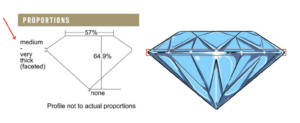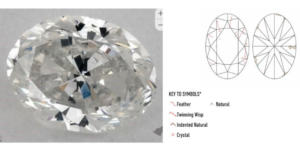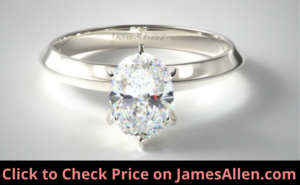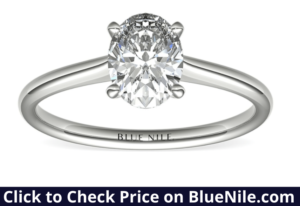
Oval cut diamonds have an elongated, round shape. It’s an alternative to a traditional round cut diamond for engagement rings and other pieces of jewelry.
The modern oval cut was developed in the mid-1900s. Its ideal length to width ratio is 1.35-1.50, so it maintains a distinct shape without appearing too pointy.
If you’re considering an oval cut for a piece of jewelry, know what to expect in terms of its overall performance.
Let’s discuss the 11 pros and cons of oval cut diamonds, including how it performs in areas like:
- Brilliance
- Size
- Durability
- Color
- Clarity
Here are the all the details.
Pros of Oval Cut Diamonds
Exhibits Strong Brilliance and Fire
Two of the most coveted traits of an engagement ring diamond is brilliance and fire. Brilliance is the white light that radiates when it collects and returns light, and fire is the flashes of color.
Buyers prioritize this quality because diamond rings are often judged by how they glimmer when twirled.
Round cuts have the highest amount of brilliance and fire, but oval cuts aren’t far behind.
For example, check out this example of an oval cut with a solitaire knife-edge setting.
If you rotate the image on the jeweler’s site, you can tell how well its sparkles.
It will outperform the brilliance of step-cuts like emerald and Asscher cut diamonds and appear comparable to the sparkle of princess, cushion radiant, and marquise cuts.
The 57 or 58 brilliant-cut facets are designed to maximize the amount of light returned to the viewer. This is a result of its kite-shaped or triangular facets.
They collect light, bounce it around inside the facets, and reflect it back, all while minimizing how much is leaked through the culet.
For an oval cut with the best light performance, choose an excellent cut, even though there’s a price premium. The quality of its cut is the most important factor in brilliance, and it’s the aspect of a diamond I always tells readers to maximize.
For my wife’s engagement ring, I did just that and chose an excellent cut.
When it’s placed in a high setting, you’ll have significant brilliance, fire, and scintillation.
Appears Larger Than Other Fancy Shapes
The size of a diamond isn’t typically referring to its length, width, or depth. Instead, it’s a measure of weight called carats, which equals 0.2 grams.
If two diamonds are both 0.75 carats, they’re considered the same size, even if one appears larger to the naked eye.
Some buyers base their decision not on a specific carat weight but its size to the naked eye, and some cuts appear larger than others.
Oval cuts look bigger than some fancy shapes. For example, if you placed a one-carat oval cut next to a one-carat Asscher cut, you might think the oval cut has a higher carat weight.

The oval cut has an elongated shape, which makes your fingers appear longer and more slim. Asscher cuts are more condensed, so they don’t have this effect.
The same idea can also be true with cushion cuts, depending on its length to width ratio.
It’s an effective way to save on the cost of your diamond because you can choose a lower carat weight than you could with other cuts.
But in other cases, a different fancy cut may appear larger than an oval cut. Marquise cuts are known for this quality, so the concept plays out in both directions.
Durability
Also consider the durability of a specific diamond cut.
One pro of oval cuts is they’re more durable than ones with sharp corners or points. These are often the weakest areas on a diamond, so baguette, princess, and marquise diamonds are susceptible to chipping if dropped or hit.
It’s also of concern if prongs place too much pressure on corners. This isn’t a problem with oval cuts.
Another weak part of a diamond is an extremely thin girdle. The girdle connects the table and pavilion, and you can find its thickness on the grading report.

My recommendation is to consider oval cuts with thin to slightly thick girdles. It strikes the ideal balance of not being too thin as to cause durability challenges but also not too thick.
Lastly, large inclusions, or imperfections in a diamond’s facets, can reduce durability.
If a large feather or cavity is located in a vulnerable area, it could end up chipping.
For example, I examined an oval cut with an SI2 clarity grade.
At a quick glance, it doesn’t appear to have heavy inclusions.
But upon viewing the GIA report, you’ll notice the presence of:
- Feathers
- Twinning wisps
- Indented naturals
- Crystals
- Naturals

They’re also located near the edges of the crown and near the girdle. So this diamond is more likely to chip if dropped compared to one with minimal inclusions.
Although oval cuts are generally more durable than many other cuts, you can improve this quality by choosing one with an ideal girdle thickness and a lack of inclusions.
Lower Cost-Per-Carat Than Round Cuts
Oval cuts are also more affordable than round cuts, with a lower cost per carat.
To best understand the differences in price between oval cuts and other shapes, I compared prices for 143 diamonds from James Allen, a leading online jewelry retailer.
The round cuts earned a very good cut grade, and all the diamonds also had the following grades:
- Carat: 1.00
- Color: G
- Clarity VS1
The average price of a round cut with those qualities was $7,675, with a range of $5,460-$8,830.
For oval cuts, the average cost was $6,286, with prices between $5,380-$7,330.

That’s a 22 percent premium for round cuts compared to oval cuts.
But oval cuts often cost more per carat than other fancy cuts.
For example, the average price for a princess cut from James Allen with those grades was $5,329. The Asscher cuts were selling for an average of $4,552.
You can put that savings toward a larger carat weight or other qualities about the diamond, such as its clarity or color grade.
Hides Some Inclusions
Another benefit of oval cuts is they hide inclusions more effectively than step-cuts.
Inclusions affect the appearance, durability, and brilliance of a diamond. Buyers are most concerned about visible inclusions.
This is why instead of focusing on whether a diamond earns an SI or VS clarity grade, you should know whether the inclusions are noticeable without magnification.
If they can’t be seen to the naked eye, it’s known as an eye-clean diamond.
The reason oval cuts disguise some inclusions is its brilliant-cut facets. When more white light is reflecting off its table, faint black spots or white feathers aren’t as visible.
You can start your search for an oval cut engagement ring diamond in the SI clarity range and work your way up to VS.
For example, this SI2 clarity diamond has several black spots on its table.
They’re apparent in the high-resolution image, and we’d expect to see them with the naked eye as well.
This diamond earned an SI1 grade. Its inclusions aren’t visible in the photo, and it likely looks that way in person.
For step-cuts like emerald, Asscher, and baguette cuts, you’ll often need to start at VS1 to achieve eye-cleanliness.
To illustrate, here’s a side-by-side comparison of an oval and emerald cut with SI1 clarity grades.

Not every oval cut with that grade is eye-clean, and not every SI1 emerald cut appears that included, but it’s a helpful examples of how cut affects cleanliness to the naked eye.
This quality also results in cost savings for oval cuts because you avoid the 10-15 percent premium for one grade higher on the scale.
Settings
There are a variety of settings that complement oval cuts.
The most popular choice is a four-prong solitaire setting, where two prongs grasp each side.
It’s a minimalist style that focuses all the attention on the center diamond.
Oval diamonds are fitting for solitaire settings because of their strong brilliance. In the cases where buyers choose a step-cut with weaker light performance, it’s common to add extra diamonds to the piece to enhance its glimmer.
You can also select a setting for your oval cut that features diamonds along the shank.
My favorite style is channel-set diamonds because they add brilliance to the ring but also secure the extra diamonds. There’s a groove within the ring where the accents sit, and a lip covers their edges to hold them in place.
Oval cuts can also be surrounded by a halo of smaller diamonds. Single and double halos add brilliance to a diamond ring without the same price increase of a center diamond with a higher carat weight.
For example, this halo setting from James Allen costs $1,470. Its total carat weight is 0.24.
If you were to add 0.24 carats to a center diamond, the marginal cost increase is often more than $2,000.
Popularity
Oval cuts are also growing in popularity as an alternative to the classic round diamond. While there are many fancy shapes to choose from, the many pros of oval cuts have caused it to rise above many others.
For example, I checked out search trends dating back almost 20 years, and you can see the consistent rise in searches for oval cuts.

I also researched 250 celebrity engagement rings to learn which cuts are the most popular. In my study, I found 18 percent (45 in total) of celebrity engagement rings were oval cuts.

I partnered with Clean Origin on this research, and they noted about 15 percent of their diamond sales are oval cuts.
So if you’re looking for an alternate to round cuts that’s still in style, consider an oval diamond.
Cons of Oval Cut Diamonds
Might Display Poor Symmetry
Some oval cut diamonds have poor symmetry.
Diamond symmetry refers to how well its facets are aligned. Both sides should mirror each other, and the table should be centered on top.
Poor symmetry diminishes its overall appeal by lessening its brilliance and causing the diamond to appear uneven. This most often results from poor craftsmanship during the cutting process.
Oval cuts are susceptible to this issue because of their unique shape.
Any shortcomings in this area could be noticeable to the naked eye. So I recommend viewing the diamond in-person or through high-resolution photos to ensure it has proper symmetry.
Another way to gain confidence in an oval cut’s symmetry is to select a diamond with a grading report from a regarded institution like the Gemological Institute of America (GIA).
They include a symmetry grade on the report ranging from “excellent” to “poor.”

One with an excellent or very good cut grade likely won’t have apparent problems with symmetry.
Bow-Tie Effect
Oval cuts are also prone to experience the bow-tie effect.
This refers to a series of black triangles that span across a diamond’s table in the shape of a bow-tie.
Check out the oval cut below with an obvious bow-tie.
It’s a blemish that often results from a poor cut because certain facets can’t capture light.
When no light enters the diamond, no light returns. The bow-tie effect is created.
The cuts that most often have a bow-tie are oval, marquise, and pear diamonds.
You can’t learn whether it has one by reading the grading report.
For example, this oval cut has an F color grade and VS1 clarity. There is still a faint bow-tie.
Fortunately, they’re easy to identify in images. If you’re shopping for a diamond online, always view photos of oval cuts to know whether it has a bow-tie.
GIA Doesn’t Provide Cut Grade
A diamond’s cut grade is a combination of traits such as:
- Proportions (length, width, and depth)
- Polish
- Symmetry
- Girdle thickness
The GIA doesn’t provide a cut grade for fancy shapes like oval cuts because there isn’t a consistent system to use for all the variations.
So it’s more difficult to learn the quality of its cuts compared to round diamonds.
Instead of a single grade, take into account how it scores across the areas that determine cut on a GIA report.
If it has excellent polish and symmetry, a thin to slightly thick girdle, and ideal proportions, it may be a quality cut.
This underscores the importance of viewing the diamond in person or through quality photos.
Shows Tints of Yellow
Colorless diamonds are the most valuable. As a diamond moves down the GIA color scale from D to Z, it shows more yellow tints.

At the bottom of the scale are “light” diamonds, which have such a strong color they can appear brown.
Similar to clarity, most buyers are concerned with the diamond appearing colorless, even if it doesn’t earn the highest color grade.
Some cuts show color more than others. So in order to achieve this effect, you have to choose a higher grade.
Oval cuts show more color than round cuts, so you’ll pay a premium for that higher grade.
For oval cuts, I recommended starting your search with I color grades.
Depending on its size, you may have to move up to H or G color grades to remove the visibility of any color.
One tip for hiding the color in an oval cut is to choose a yellow or rose gold setting.
As an example, here’s an engagement ring in yellow gold.
The contrast in color will make the diamond look less yellow.
How to Decide if an Oval Cut Diamond is Right For You
By understanding the pros and cons of oval cut diamonds, you can decide whether it’s right for your diamond ring.
Round cuts and all fancy shapes have benefits and drawbacks, so it’s about choosing which qualities in a diamond are important to you.
Here are some guidelines to help you decide whether the advantages of oval cuts outweigh the disadvantages.
Choose an oval cut if:
- You want a diamond similar to a round cut but that has unique characteristics compared to that traditional cut
- You want a cut with a lower cost per carat so you can put the savings into improved grades or a quality setting
- You’re choosing a clarity and color grade that make the oval cut appear eye-clean and colorless
By pairing your choice of diamond with multiple types of settings, you’ll create an oval cut ring that will last a lifetime.

Jacob Clarke
Jacob Clarke is the founder of TeachJewelry.com.
He earned an Applied Jewelry Professional Diploma from the Gemological Institute of America (GIA) and now brings you essential information about diamonds, settings, and more.
Jacob has consulted with leading jewelry brands, and his work has been cited in Clean Origin, Diamond Nexus and industry publications.
He's also a member of the International Gem Society.
He enjoys discussing jewelry with readers, so contact him with any questions at jacob.clarke@teachjewelry.com.


















